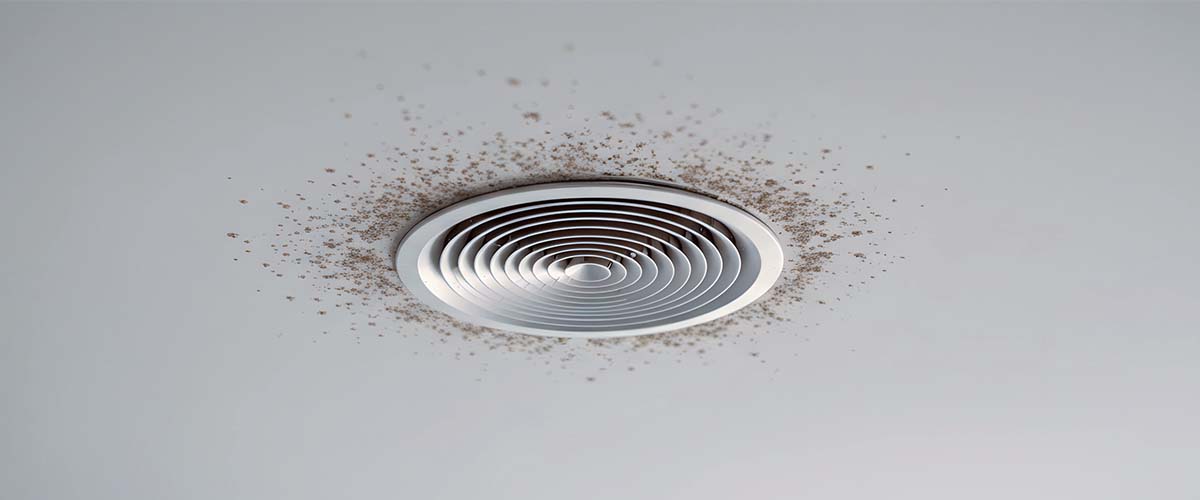You’re not imagining that earthy, wet-basement smell every time the AC kicks on. When mold takes hold inside or around air vents, it piggybacks on the airflow and announces itself with a musty puff. You might notice speckled black or greenish flecks on the register, a little slimy film by the edges, or a gritty, gray lint that sticks to your fingers when you wipe something off a surface. I’ve cracked open a vent and felt that cool, metallic grille give way with a dusty sigh—and instantly smelled mold in the air vents. Don’t panic. Air vent mold removal works, and we’ll keep it simple and safe.
Causes and Signs of Mold in Air Vents
Mold requires three essential elements: moisture, a suitable food source, and time. Air ducts don’t have crumbs like your pantry, but dust is enough food—skin flakes, fabric fibers, and pollen. Moisture sneaks in when warm, humid air meets the chilled metal of your system and condenses. That’s why the supply vents and the first few inches of duct behind them are common spots. The evaporator coil and the drain pan can also go slimy when the pan clogs or the coil stays damp.
A musty odor when the blower starts, dark smudges that appear fuzzy or smeared, or recurring “dirt” rings around vents are all telltale signs. In a humid summer climate, this issue occurs more frequently after prolonged cooling cycles or when the fan runs continuously. One more thing: not every black mark is mold—soot from candles or a dusty return can leave similar shadows—but if it smells earthy or looks patchy and grows back fast, treat it seriously. Mold fragments can irritate airways even if you’re not allergic, potentially leading to respiratory issues or exacerbating existing conditions.
Air Vent Mold Removal
Start by turning the system off at the thermostat. Pop off the register cover with a screwdriver. If it’s metal, wash it in hot, soapy water, then disinfect with 70% isopropyl alcohol or hydrogen peroxide, and dry completely until it squeaks under your towel. Wear gloves and a mask; the spores are as light as dandelion fluff.
Gently vacuum the first foot of the duct interior and the surrounding drywall with a HEPA vacuum. Lightly mist a towel with peroxide or a cleaner labeled for mold on nonporous surfaces and wipe the reachable metal. Avoid soaking insulation. Don’t use bleach—it’s harsh on metal, doesn’t penetrate porous dust, and releases fumes you don’t want to breathe.
Replace your air filter with a fresh MERV 8–11. Higher isn’t always better; too high can strain some systems. Clear the AC drain line: pour a cup of white vinegar into the access tee and ensure the outside drain drips steadily. If it’s clogged, a wet/dry vac on the exterior drain can help. After cleaning, run the system on cool with the fan set to Auto, not On, to dehumidify without constant airflow that keeps things damp.
Preventing Mold in Air Vents
Think moisture control first. Aim for an indoor humidity level of around 40–50%. If it’s higher, a dehumidifier in problem rooms—or a whole‑home unit, if you have persistent issues—can tip the balance. Seal and insulate any sweating ductwork in attics or crawlspaces; cold metal in hot, humid air is a recipe for condensation. I once wrapped a short stretch of bare supply trunk with proper insulation, and the “mystery” mold at the nearest vent stopped returning.
Change filters on schedule, typically every one to three months, depending on the number of pets and the level of dust. Keep the fan setting on Auto. Running the fan constantly can pull moisture off the coil before it drains, causing damp air to be sent through the ducts. Have the evaporator coil and drain pan inspected and cleaned each spring. A clean coil dries faster and sheds less biofilm. UV lights can help keep the coil cleaner between services, but they don’t fix drainage or wet insulation.
Mind the house, too: repair roof or plumbing leaks immediately, use bath and kitchen exhaust fans, and keep supply vents and the main return unobstructed so airflow stays balanced. If you have a crawlspace, proper vapor barriers, ventilation, or encapsulation can make a huge difference. In places like Milledgeville, Georgia, our long, sticky summers mean prevention is mostly about keeping things dry and moving.
When to Call Professionals for Air Vent Mold Removal
Contact a professional when the smell is present throughout the house, you see growth beyond the register area, or the problem recurs within weeks despite cleaning. Also, call if you suspect the lining inside the ducts is made of fiberboard or is internally insulated—those materials can hold moisture and are not DIY-friendly. If someone in the home has asthma, severe allergies, or is immunocompromised, don’t wait.
A qualified HVAC or NADCA-certified duct cleaning company will inspect the coil, blower, drain, and ducts, measure humidity and static pressure, and look for insulation gaps or air leaks that allow muggy air to enter the system. Proper cleaning involves negative-pressure containment, HEPA vacuums, and agitation tools—not a quick “blow and go.” They may sanitize metal surfaces with an EPA-registered product appropriate for HVAC, clear and level the drain pan, flush the drain line, and recommend sealing leaky ducts or replacing moldy flex or ductboard sections. Ask them to show before/after photos or camera footage.
Costs vary depending on whether it’s a simple cleaning or more extensive ductwork, so be wary of very low quotes and of blanket chemical fogging without cleaning or explanation. The goal isn’t perfume—it’s dry, clean surfaces and steady airflow.
FAQs About Mold in Air Vents
Is it safe for me to clean the air vents myself if there is mold present?
Yes, if it’s limited to the register and the first foot of the metal duct, you can clean it yourself. Ensure you use PPE and gentle cleaners. Anything widespread or on porous materials needs a pro.
Will bleach kill the mold in the air vents?
It can be used on hard surfaces, but it’s not recommended for use inside HVAC systems. Use alcohol, peroxide, or EPA-labeled HVAC products instead.
How often should I change filters?
Typically every 1–3 months. Check monthly at first; if it looks gray and fuzzy, replace it.
Do air purifiers help?
A HEPA purifier can reduce airborne spores in rooms you occupy, but it won’t fix moisture or clean ducts. Pair it with humidity control and HVAC maintenance.



